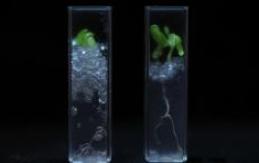Podcast: Play in new window
BOB HIRSHON (host):
See-through soil. I’m Bob Hirshon and this is Science Update.
Understanding how plant roots interact with soil could lead to insights in agriculture, climate change, and even disease. The big problem? You can’t see through dirt. That’s why researchers in Scotland designed a transparent soil substitute. According to biologist Lionel DuPuy of the James Hutton Institute, it’s made from a polymer that’s quite different from soil. But plant roots take to it, and the polymer can be electrically charged to traffic soil nutrients.
LIONEL DuPUY (James Hutton Institute, Dundee, Scotland):
So it doesn’t have to reproduce the exact chemical structure, as long as it can be charged – and therefore attract the nutrients.
HIRSHON:
His team also showed that the polymer can support E. coli, a kind of bacteria that sickens humans by colonizing foods like lettuce. The researchers hope that the material will bring new clarity to plant research. The study appears in the journal PLoS One. I’m Bob Hirshon for AAAS, the Science Society.

